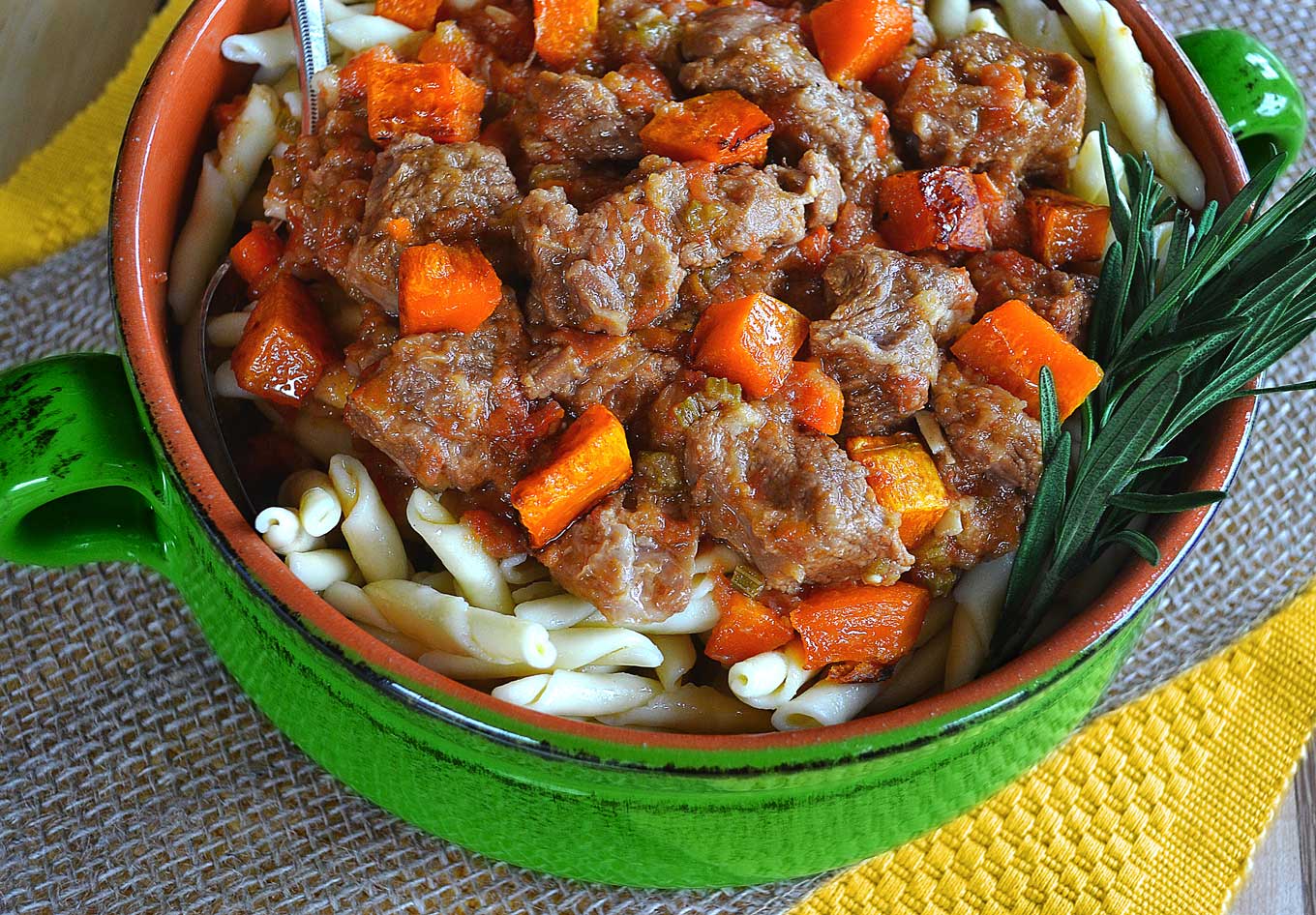
I normally don’t cook veal, finding calves far too cute and their fate far too tragic. Once or twice a year, this veal & roasted butternut squash pasta dish is my only exception. Yes, it’s THAT good. And with 10 days to go before the start of Spring, I got busy braising this little exception.
It tastes exceptionally good with pasta. I used truccioli in this incantation because they open up ever so slightly when they cook in water and are then better able to capture the amazing sauce in this braise.
But you don’t have to eat it with pasta, of course. Ladle some out in a bowl and serve with some nice rustic, crusty gourmet bread and you’re all set. Delicious!
But I have kids, you see, and when the evening’s meal offering is not a staple (like these succulent veal morsels that I hardly ever make) and I feel like having a dinner experience free of suspicious ‘what is this?‘ and ‘am I going to like it?‘ and even better…‘if I don’t like it, can I make myself a peanut butter and jelly sandwich?‘ then I make sure that pasta is our dinner companion.
I don’t know why, but pasta has a way of reassuring my kids. No matter what unfamiliar concoction mom has cooked up, if they see pasta in the dish, they know that somehow it’s going to be alright. And then when I break out our little glass bowl filled with delectable Parmigiano-Reggiano for them to sprinkle on top, order is restored in their jumbled, slightly shaken universe and they miraculously open themselves up to the possibilities of the evening’s fare. I don’t even question it anymore. Like any smart parent, I go with it. And then some.
The savory, slightly unctuous sauce that results from this braise makes this dish a real winner…and not just with kids I might add!
After reading quite a bit about braising, I’ve learned that the sauce from a braise becomes otherworldly because of a sort of osmosis that occurs between the meat pieces and the liquids, in the form of stock or wine, that get added to the cooking process. At first, the salt with which you season the meat helps to draw out the juices of the meat into the liquids. This further flavors the savory sauce that’s slowly developing in the pot. Then, at some point during the simmering process, the meat starts reabsorbing some of the sauce in which it is cooking. This not only reinserts some of its own meaty savoriness back in, but also the flavors of the wine and the other ingredients you are using in the braise. So when you bite into that dewy piece of meat, you’re tasting the heavenly amalgamation of every ingredient you have put in the pot. It completely makes sense.
No wonder braises taste even better the next day! The flavors have gotten to intertwine with each other even more.
The melt-in-your-mouth veal pieces come a close second as far as what makes this dish special. I knew from reading about, and experimenting with, braises that the magic happens when the tough, chewy ligaments found in meat break down, though a long and slow cooking process, into gelatin. That’s what creates the succulence and buttery texture. But the process became even clearer when I found this great blog post from The Reluctant Gourmet that explains all about the braising process. If you get a chance, give it a looksy as it’s chock full of helpful and potentially ‘cool! I didn’t know that!’ information.
Finally, it also doesn’t hurt that the roasted butternut squash adds the sweetest note to this tasty dish. That and the lightest and most satisfying of crunches from where those cute little orange nuggets have caramelized in the oven. Yum!
making veal & roasted butternut squash pasta
Heat 2 TBSPs of olive oil on medium-high heat in a large, heavy-bottomed pot (Dutch ovens are ideal) . Add 1 medium-sized Vidalia onion, 1 large celery stalk, and 1 carrot, all diced, and cook for 8 minutes or so, or until the onions are translucent.

Then add 2 thinly sliced cloves of garlic and cook for another 2 minutes, stirring frequently.

Add a pinch of salt and mix well.
Add 1 ½ lbs. of cubed lean veal meat and saute’ until lightly browned, stirring occasionally.

Add another pinch of salt and some pepper and mix. Pretty soon the meat will start to darken and you’ll begin to see some of that fond, or the little roasty bits on the bottom of a pan that develop when you’re cooking something,

They will loosen when you add the liquid of the braise and will add remarkable flavor.
Add 5 ripe and really red plum tomatoes, diced, and a sachet containing 1 large sprig of rosemary.

While it’s perfectly acceptable to just throw the sprig of rosemary in the pot, I’ve found that I prefer the control of being able to take out the rosemary at will and try doing that without a sachet! Typically the rosemary spikes will detach from the stem and become almost impossible to retrieve. I like to have that control not just because I’m completely OCD about some cooking-related things, though I absolutely am, but also because strongly-favored herbs like rosemary are generous and they become the flavoring ingredient that just keeps on giving and giving and giving. And giving.
And giving.
Get the idea? They give so much that eventually all you end up tasting is a heavy cloak of piney essence over any other taste in the dish. And especially if the dish is being prepared a day ahead or will be consumed over the course of a few days, the scent and flavor of rosemary becomes overpowering. To me, anyway. And I love love love rosemary! So I just make a sachet and go merrily on my way.
To make one, cut a small square of cheesecloth and place the rosemary on it.

Then tie it up with kitchen string.

Then cut off the excess cheesecloth. Ta-da!

Stir for a minute after adding the tomatoes, rosemary and just another pinch of salt. Finally, add 3 cups of warmed veal or chicken stock and bring the stew back up to a boil.

Then, cover the pot and allow to simmer gently (Gently!) over low heat for 1 hour.
Once the veal is simmering away, prepare 1 medium butternut squash. Preheat the oven to 425°F. Cut off both ends.

Lay the squash on its side. Cut it horizontally, separating the top part from the wider, more bulbous bottom.

Slice the bottom part in half to scoop out the seeds and fibrous insides with a spoon. Then, peel the squash.

Cut it into ½-inch thick slices.

Finally, cut each slice into bars and then each bars into ½-inch cubes.

Place the cubes on a baking tray and sprinkle 2 tablespoons of olive oil.

Massage them with your hands to make sure all cubes are covered with the oil.

Put the tray in the oven and turn down the temperature to 400°F. Roast for about 30 minutes, or until tender. Take them out and sprinkle with just a hint of sea salt.
Cook ¾ lb. of pasta of your choice in boiling, salted water until it’s al dente, or softened but still very firm. Drain and toss with the veal sauce. Serve in individual bowl and top with the roasted butternut squash and with freshly-grated Parmigiano-Reggiano. Makes 4 servings.





Leave a Reply